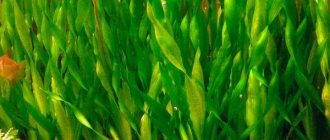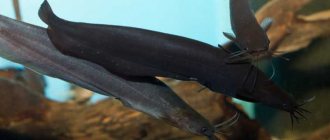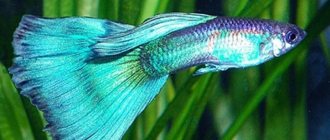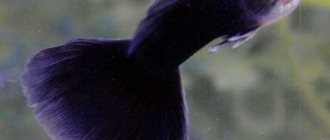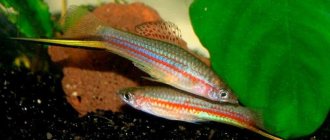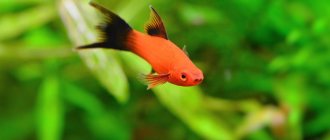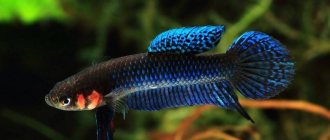Julidochromis are exotic fish, endemic to the deep Lake Tanganyika in East Africa (Lake Tanganyika is located in Africa at an altitude of 773 m above sea level. Its area of 33,000 km2 is the second largest lake on the continent. Its length is 650 km, and its greatest width is 80 km It has now been established that the lake is home to 164 species of endemic cichlids).
Tanganyika cichlids are found in the coastal rocky zone and do not swim to depth. This is most likely why they were well studied.
The genus Julidochromis has only five species , each of which has its own varieties, divided according to geographical characteristics, these are:
Julidochromis Regani;
Julidochromis Marlieri;
Julidochromis Ornatus;
Julidochromis Dickfeldi;
Julidochromis Transcriptus;
These species also have several variable forms, depending on their geographical habitat, where individuals differ in color shades and scale patterns. All other forms of these fish were obtained as a result of selection work and do not have separate names.
All julidochromis have common properties: a pointed head, an elongated body, the mouth is located at the bottom of the head, the dorsal fin is long and sharp, and the color is spotted. The spots may differ from each other in color and shape.
Life expectancy in the wild is from 10 to 15 years.
Habitat
The historical homeland of julidochromis is Lake Tanganyika, located in the eastern part of the African continent. These fish are considered endemic, which means that they can only be found in this lake and nowhere else.
Lake Tanganyika, although not too deep, has rocky grottoes, sandy shelters and parameters of the aquatic environment suitable for the life of cichlids.
However, thanks to their decorative qualities and interesting habits, these fish have long gained immense popularity among aquarists around the world. Therefore, julidochromis are often found in artificial reservoirs in different parts of the world.
Spreading
Lake Tanganyika was discovered by Europeans only in 1858.
For the local population, it has long served as a nurse, since there are quite a lot of fish in the waters. Julidochromis live in shallow waters in coastal areas and do not venture into the depths, which is why they were discovered. All year round, the water in the lake is warm in the surface layers, although at a depth of almost one and a half kilometers the temperature is only 5 - 6 degrees.
Water has an alkaline reaction due to the large amount of dissolved salts, in particular magnesium salts.
In their biotope, julidochromis are predators; they eat invertebrate inhabitants. They can also eat algal fouling on coastal rocks.
Appearance
Julidochromis may differ from each other depending on the specific subspecies. But all representatives have common appearance features:
- Size . Characterized by medium sizes. The size of an adult individual ranges from 6 to 12 cm. Moreover, the females are somewhat larger and more massive than the males.
- Body . All julidochromis, regardless of the subspecies, have an elongated and elongated body and a slender physique. The upper part of the fish’s body, due to its unusual cylindrical shape, resembles a torpedo.
- Head . Large and somewhat pointed. The oral cavity is located in the lower part of the head and is small in size, attracting attention with its unusual shape, as if slightly pushed forward.
- Fins . A pointed and long dorsal fin with a spotted color is a distinctive feature of julidochromis fish. The caudal fin is fan-shaped and covered with numerous light spots.
- Color. The colors of these fish are dominated by brown and terracotta tones, with black stripes running along the body. At the same time, the color largely depends on the type of julidochromis, the diet, and the conditions of detention. Breeders bred fish with black and white, yellow and black, and spotted colors. Such julidochromis are not found in nature, but they look extremely impressive and are in great demand among aquarists.
Julidochromis differ slightly from each other in appearance, with the exception of size and variations in color. As for the conditions of keeping and caring for these fish, they are absolutely identical.
General information
Julidochromis sp. is a genus of tropical freshwater fish from the Cichlid family. Representatives are found only in the African Lake Tanganyika. They have a body shape that is unusual for most cichlids and an attractive striped coloration. Among the amazing forms of behavior, it is worth highlighting the monogamy of julidochromis: the resulting pairs are very strong and last a lifetime.
Currently, the genus includes only 6 species, but the number of color morphs, as well as natural and artificial hybrids, is much larger. Julidochromis owe their popularity not least to their peaceful disposition: they can be kept with almost any medium-sized fish.
Varieties
In nature, there are 5 subspecies of julidochromis, which have certain specific differences. Moreover, all varieties are not selective. Their appearance is determined by the habitat of the individuals, because Lake Tanganyika has a vast area. Different parts of the reservoir may have different depths, shading, and temperatures, which over time has led to the formation of several types of julidochromis.
Julidochromis Regani
Julidochromis Regan is the largest and most massive representative of this fish species, with a peaceful character, but pronounced territoriality. Therefore, when the aquarium is overcrowded, they often have conflicts and even fights with their relatives.
Appearance of Julidochromis Regan:
- Size. In a natural habitat, the size of an adult is about 30 cm. When raised in an artificial reservoir, males usually reach a length of about 12-15 cm, and females up to 10 cm.
- Body. He has a fairly large and strong build. The body has a more rounded shape than other subspecies.
- The head is small and pointed.
- The fins are medium in size and have an unusual color: the tail and dorsal fins are painted in a rich bright blue color, the pectoral fin has a golden-red hue.
- Color. The colors of these fish are dominated by yellow, golden and brown colors in all their variety of shades. There are pronounced black stripes running along the body, which makes the color of this fish similar to the color of a tiger’s skin. The gills are covered with dark spots, and along the tail there are numerous light spots.
Gender differences. Females differ from males in having a more graceful physique and a rounded abdomen. In addition, the coloring of males is brighter and more saturated.
The average life expectancy in an artificial environment varies from 10 to 15 years.
Julidochromis Marlieri
Julidochromis Marliera is a fish that attracts aquarists with its unusual colors and decorative properties, as well as its peaceful character.
Appearance of Julidochromis Marliera:
- Size. The size of an adult fish is about 13 cm, although in a natural environment or a large artificial reservoir it can grow up to 15 cm.
- The body is elongated and graceful, resembling a torpedo.
- The head is pointed and small, like other species of julidochromis.
- The fins are distinguished by their sky-blue color and appear translucent in the aquatic environment. Against this background, the black contrasting edging looks especially impressive. Often the fins of this subspecies are covered with a bizarre mesh pattern or pattern formed by thin, ornate black lines.
Sexual differences . You can distinguish a male from a female thanks to a special subcutaneous fatty growth located on the head of the fish, which is formed when the individual reaches sexual maturity. This is a distinctive appearance feature inherent exclusively in Marlier julidochromis.
Life expectancy is from 10 to 12 years.
Julidochromis Ornatus
Julidochromis Ornatus is a very spectacular fish that can decorate any artificial reservoir. Its second name is “golden lure”. It is quite rare in nature and is very highly valued among aquarists.
Appearance of Julidochromis Ornatus fish:
- Size. The length of an adult varies from 8 to 12 cm.
- The body has a graceful, elongated, elongated shape. A distinctive feature of Julidochromis Ornatus is the funny habit of swimming on its stomach, with its back down, which often worries aquarists. In fact, this behavior indicates the beginning of the spawning period and the readiness of the fish to reproduce.
- Head. The slightly elongated muzzle resembles a bird's beak. There is a small hump at the top of the head.
- The fins are unpaired, framed by a light blue edging, which appears turquoise in the aquatic environment and shimmers beautifully in the light.
- Coloring is the main advantage of this species of julidochromis, striking in its beauty and luxurious shine. The body of the fish itself is covered with golden-yellow scales, sparkling in the light. At the base of the tail there is a rounded dark spot. Black stripes run along the back and sides of the fish, effectively contrasting with the main color and standing out against the overall golden background.
Gender differences. It is quite difficult to distinguish a female from a male. Females are somewhat smaller in size than males, and their colors, although just as bright and original, lack the pronounced shine characteristic of males.
The average life expectancy, depending on the conditions of detention, varies from 10 to 12 years.
Julidochromis Dickfeldi
Julidochromis Dikfeldi is the smallest variety with a spectacular appearance and calm character. Suitable for keeping in small artificial reservoirs.
Appearance:
- Size. In its natural habitat, the size of the fish can reach 10 cm, but when grown in aquarium conditions, the size of an adult does not exceed 6 cm.
- Body. They are distinguished by their graceful physique and innate grace, which attracts attention when watching the movement of a school of these fish in an aquarium.
- The head is small and narrow with a small mouth and large expressive eyes.
- The fins are medium in size and decorated with a bright blue edging.
- Color. The characteristic color combination of these fish is the pearlescent tint of the scales and numerous blue sparkles, randomly located along the entire body. Color can vary from cream to white tones. But thanks to its pearlescent shine, the fish looks extremely impressive. Less common are Julidochromis Dikfeldi with brown and purple shades dominating the color.
Sex differences. Females are usually slightly smaller than males, have a rounded abdomen and are less brightly colored.
Life expectancy in an aquarium is 10-12 years.
Julidochromis Transcriptus
Julidochromis Transcriptus (the second name of this fish is masked) is extremely popular due to its unique combination of original appearance, graceful size suitable for keeping in small tanks, and unpretentiousness in terms of care.
Appearance of Julidochromis Transcriptus fish:
- Size: no more than 6-7 cm.
- Body. They have an elegant physique and an elongated body with an elongated cylindrical shape.
- The head is small, proportional in relation to the body. Black stripes around the eyes create a mask effect that draws attention to the fish's face.
- Fins have a smooth, rounded shape. Decorated with blue trim around the edges.
- Color. Against a general background of yellow-beige color there are ornate designs and patterns formed by wide black stripes. A large number of black inclusions gives the impression that dark tones dominate the color of the fish.
Gender differences. You can distinguish a male from a female by its bright coloring and larger dorsal and anal fins.
The average life expectancy is from 10 to 13 years.
Conditions of detention
Julidochromis are quite unpretentious in terms of care, and therefore are suitable even for beginner aquarists. But in order for the fish to maintain its beauty, be healthy, active and live longer, it is necessary to create optimal conditions for it, as close as possible to its natural habitat:
- Choosing an aquarium . Since julidochromis are quite large, mobile, active fish, leading a predominantly school lifestyle, preference should be given to a fairly spacious artificial reservoir, designed for at least 60-80 liters. The size of the reservoir depends on the expected number of potential residents. It is important to ensure there is enough free space for movement. Yulidochromis are territorial, and overpopulation of an artificial reservoir inevitably leads to skirmishes and manifestations of aggression. Given the ability of these fish to jump out of the aquarium, it is recommended to cover it with protective glass or a lid.
- Water parameters : temperature range - from +24 to + 30 °C; hardness - from 15 to 18 dGh; acidity - from 6.7 to 7.6 units.
- Filtration is required to be quite powerful, since these fish are sensitive to pollution and do not tolerate stagnant water well. Cleaning the aquarium and replacing fluid in an artificial reservoir should be carried out at least once a week with a concomitant water change of at least 20% of the total volume.
- Aeration should be of sufficient quality, since julidochromis need an increased amount of oxygen.
- Vegetation . The more green spaces, algae, aquatic and surface cultures are present in the aquarium, the more comfortable and calm these fish will feel. At the same time, it is better to plant plants at the back walls of the artificial reservoir and along the edges, leaving in the center a sufficient amount of free space for games and movement. An excellent choice would be crops such as cryptocoryne, Java moss, hornwort, and algae.
- Lighting . A fairly bright and intense light is required, especially since with enhanced lighting these fish look most impressive. But it is important to ensure that the aquarium has shaded corners intended for relaxation.
- Decorating an aquarium . When creating an aquarium design, it is worth using various ceramic houses, castles, caves, grottoes, which will serve as shelter for fish. Driftwood and large stones are well suited for these purposes.
- Soil - it is best to choose sandy or small pebbles.
- Feeding. The ideal option for julidochromis would be live or frozen food (brine shrimp, daphnia, bloodworms, crustaceans, cyclops). From time to time, you can add herbal supplements, small pieces of vegetables and fruits, and herbs to your diet. Granular, ready-made food is also suitable. However, given the small size of the fish's mouth, it is important that the food is small.
In general, caring for julidochromis is simple. These fish are quite stress-resistant, not picky about food and have good adaptive abilities.
The main thing is to properly design the artificial reservoir and provide a varied diet.
Nutrition
The diet should consist of frozen meat or live foods with herbal supplements. For example, bloodworms, brine shrimp together with spirulina flakes or pieces of nori seaweed. Dry sinking foods can be served as sources of vitamins and microelements, but they should not be the basis of food.
Our product Aqvium natural dry food for small and medium fish from clean lakes of Siberia and Northern Crimea in environmentally friendly biodegradable packaging.
Find out more
Breeding and reproduction
Julidochromis reproduce well in an aquarium environment. To guarantee the production of healthy offspring, care should be taken to create optimal conditions for breeding.
Preparing for spawning. During the spawning period, males become quite aggressive both towards their relatives and towards other aquarium inhabitants. Therefore, in order to avoid conflicts, the aquarist should select a couple of the most beautiful and healthy individuals of different sexes and place them in a separate aquarium - a spawning tank.
However, in some varieties of julidochromis, the process of pair formation occurs naturally. The aquarist needs to carefully observe the behavior of the pets. After some time, you can detect increased attention from the male to a certain female. Only after this can the couple be moved to the spawning area.
Requirements for the spawning tank:
- The average tank volume should be about 60 liters.
- Decorate with green spaces and decorative elements that can serve as a place for fish to hide and lay eggs.
- It is important to maintain optimal parameters of the aquatic environment and ensure choral aeration and filtration.
- The temperature regime should be at least +25°C; raising the temperature to +30°C activates the spawning process.
During preparation for spawning, fish should be fed more often than usual, and exclusively with fortified live food. Despite a fairly long life span (about 10 years), julidochromis retain reproductive function and the ability to reproduce offspring only until they reach 5 years of age.
Spawning. The spawning period can last from several hours to 2-3 days, depending on the type of julidochromis and the conditions of detention. During this time, the female lays from 40 to 100 eggs, which the male carries to a secluded place.
The fry are born 5–7 days after the eggs are laid.
Yulidochromis have fairly well-expressed parental instincts. The female cares for the offspring, and the male guards the territory, protecting the babies. Unlike many other ornamental fish, julidochromis do not consume their eggs and do not harm their offspring. Therefore, at first the kids are under the care of their parents. After a few weeks, when the fry are already beginning to swim, the adults can be moved back to a common artificial pond.
Caring for offspring. Caring for julidochromis fry does not bring much trouble to the aquarist, because at first the babies are under the care of their parents. In the future, it is important to simply take care of maintaining cleanliness in the aquarium, changing the water by 30% of the total volume 2 times throughout the week, to ensure moderate filtration and aeration, without strong currents. The temperature regime gradually decreases to values identical to the water temperature in a general aquarium.
Babies should be fed “live dust”, daphnia, brine shrimp, and specialized food for fry, which can be purchased at a pet store.
Yulidochromis reach sexual maturity at 10 months.
By this time, the fish noticeably increase in size and acquire a color characteristic of a particular subspecies.
After this, the youngsters can be safely moved to a common artificial pond with other aquarium inhabitants. It is not recommended to do this earlier, since julidochromis that have not formed a pair can destroy the eggs or fry.
Neighborhood
A good solution would be to keep a mono-aquarium with julidochromis. These fish are quite lively and interesting, and the selected varieties have quite attractive colors.
However, a multi-species aquarium is also possible. The main criterion for selecting neighbors is the non-aggressiveness of the fish and its impressive size. In other words, it should be not much smaller than Julidochromis itself.
Large aquariums contain several different species of cichlids with similar environmental requirements. It is better not to allow small characins and swordtails into the aquarium: the former can become prey due to their size, and the latter due to their annoying and cocky character.
Behavior in the aquarium and compatibility
Yulidochromis are active, playful and peaceful. These fish get along well with other aquarium inhabitants. Manifestations of aggression are possible only during the spawning period or when attempting to invade the territory chosen by the fish. That is why it is important to take care of a sufficiently voluminous artificial reservoir, especially if julidochromis are supposed to be kept together with other types of ornamental fish, mollusks, shrimp and other aquarium inhabitants.
Yulidochromis do not get along with:
- barbs;
- large predatory fish;
- Ampularia snails.
They will view these peace-loving fish as potential prey.
Yulidochromis are beautiful, funny and do not require close attention. These fish are in good health and do not require special care, so they are an excellent choice even for beginner aquarists. All julidochromis need for a comfortable and long life is a sufficient amount of free space, the absence of sudden changes in the aquatic environment and nutritious food with a predominance of animal protein in the diet. With good care, these fish are active and delight the eye with their exotic beauty for many years.

